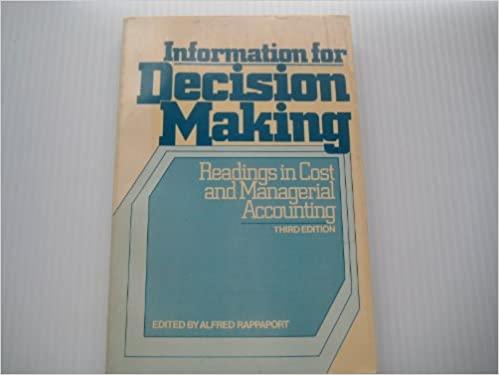Answered step by step
Verified Expert Solution
Question
1 Approved Answer
you have to relate the given statements with the straight line, diminishing balance and units of production method. If a particular statement is applicable to
you have to relate the given statements with the straight line, diminishing balance and units of production method. If a particular statement is applicable to more than 1 method, you have to write the statement number in both or all of the methods.
Calculating and recording depreciationconcepts
1. A common depreciation rate is double the straight-line rate
2. Annual depreciation is prorated if used for part of the year
3. Annual percentage rate of depreciation = 100% estimated useful life
4. Assumes economic benefits used vary significantly from one period to another
5. Assumes more economic benefits will be used in the earliest years of the assets life
6. Carrying amount = Cost less accumulated depreciation
7. Carrying amount at the end of the useful life = residual value
8. Depreciation expense = depreciable amount x percentage rate
9. Depreciation expense = units of output during the year x depreciation rate per unit
10. Depreciation expense decreases annually over the assets useful life
11. Depreciation expense is based on a diminishing carrying amount
12. Depreciation expense is calculated by multiplying the carrying amount at the beginning of the year by the depreciation rate
13. Depreciation expense is the same amount each year of the assets useful life
14. Depreciation rate per unit = depreciable amount units of production for the entire useful life
15. Depreciation rate remains constant from year to year.
16. Depreciation stops when the assets carrying amount equals its estimated residual value
17. Does not impact cash flow
18. Does not require partial year depreciation
19. Final years depreciation amount is adjusted so the carrying amount equals the residual value
20. Journal entry to record depreciation expense requires a credit to Accumulated Depreciation
21. Journal entry to record depreciation expense requires a debit to Depreciation Expense.
22. Not suitable for assets like buildings or furniture
23. Residual value is deducted from the assets cost to determine the depreciable amount
24. Residual value is not included in determining the depreciation rate or depreciation expense
25. Results in lower profit during the first years
26. Total depreciation over the life of the asset is equal to the depreciable amount
27. Used by the majority of publicly-traded companies
28. Used when management estimates the economic benefits of the assets will be used evenly over the assets useful life
29. Useful life is not expressed in time (e.g. years)--useful life is estimated total units of production
30. Used for an asset whose activity can be measured in units of output
31. Widely used for depreciation of natural resources
Step by Step Solution
There are 3 Steps involved in it
Step: 1

Get Instant Access to Expert-Tailored Solutions
See step-by-step solutions with expert insights and AI powered tools for academic success
Step: 2

Step: 3

Ace Your Homework with AI
Get the answers you need in no time with our AI-driven, step-by-step assistance
Get Started


